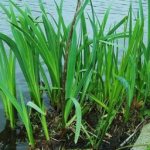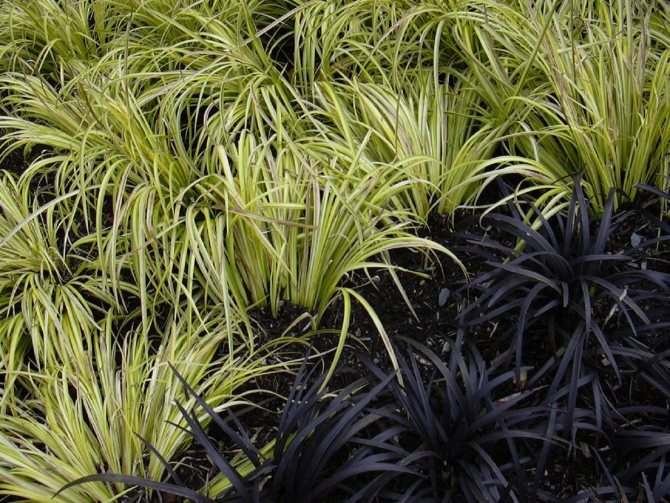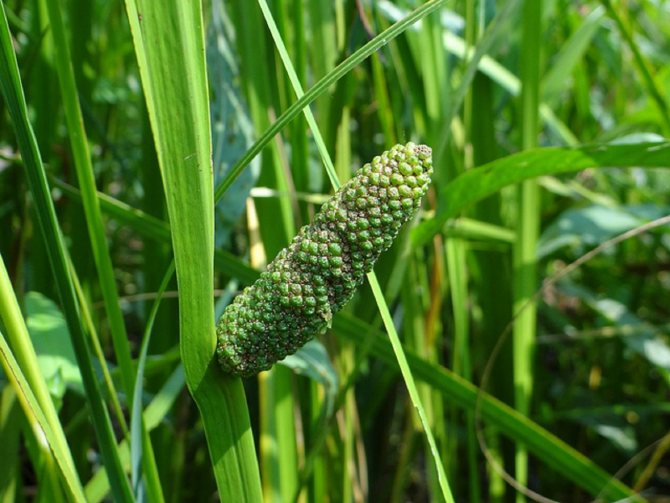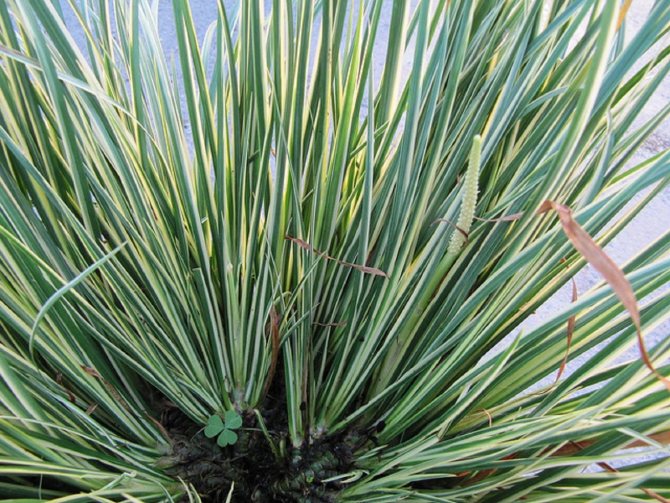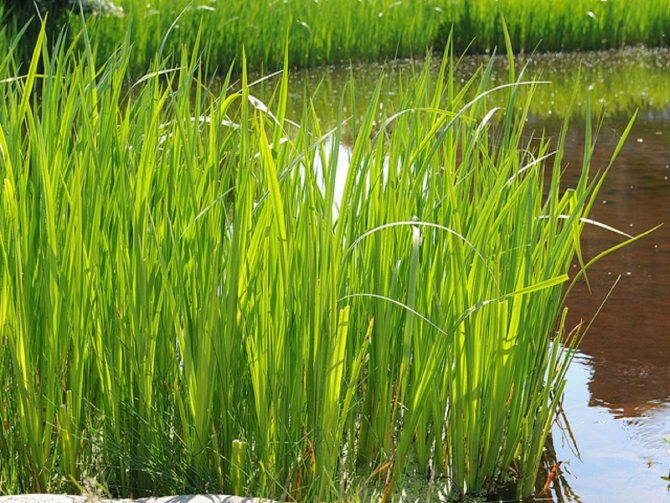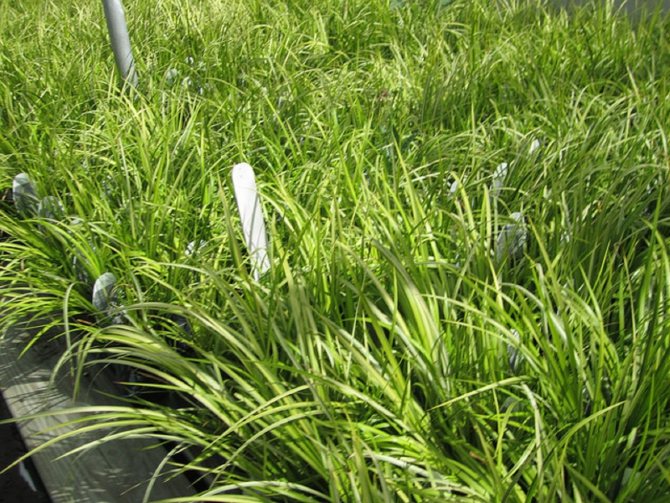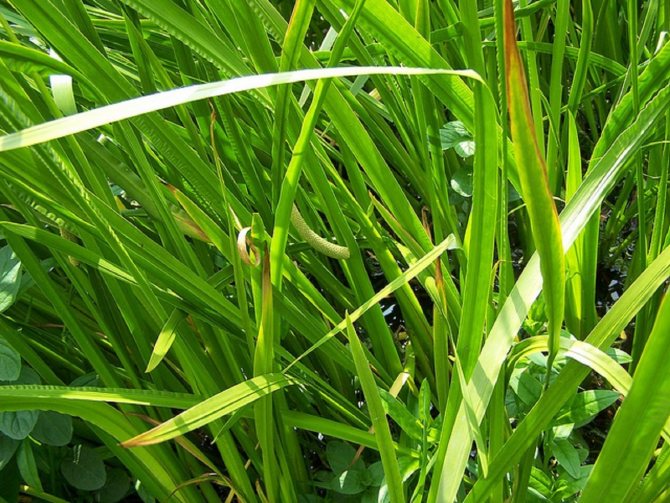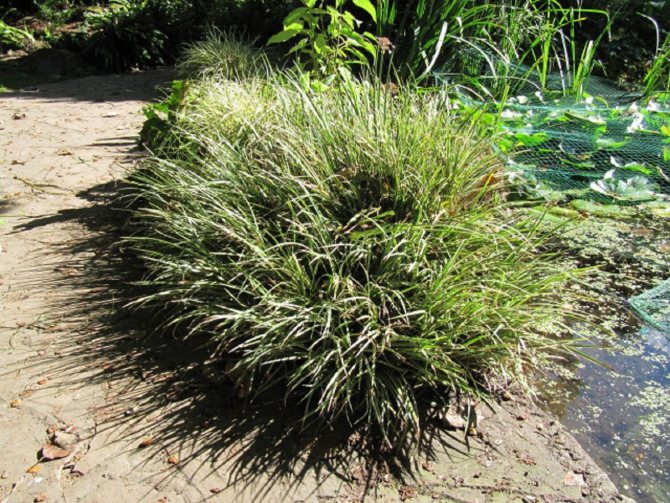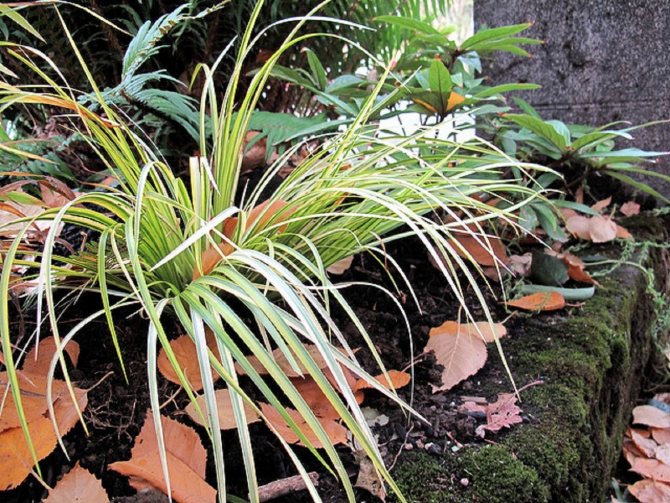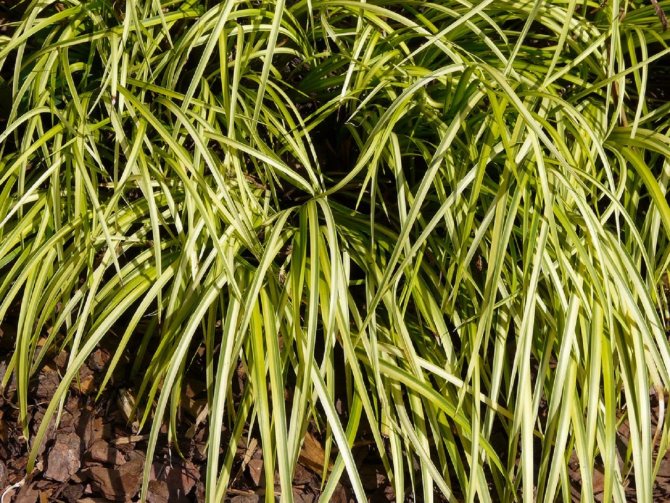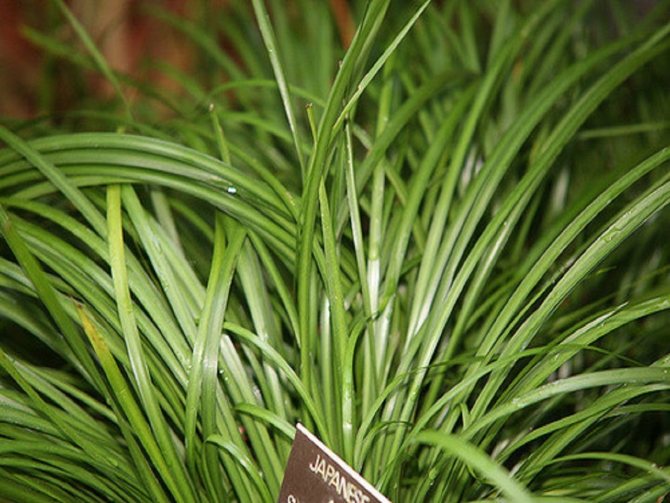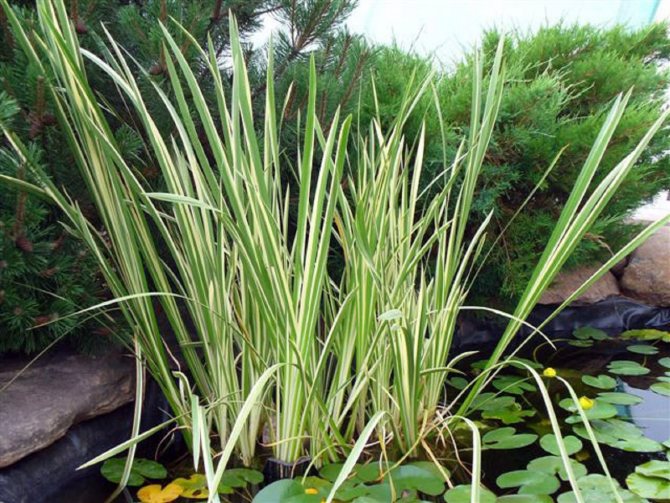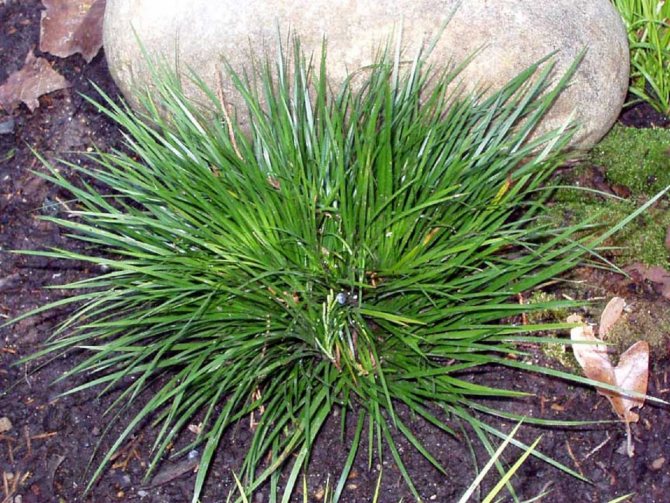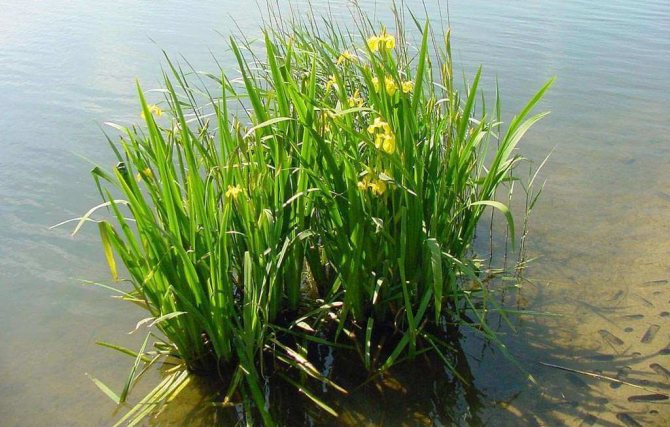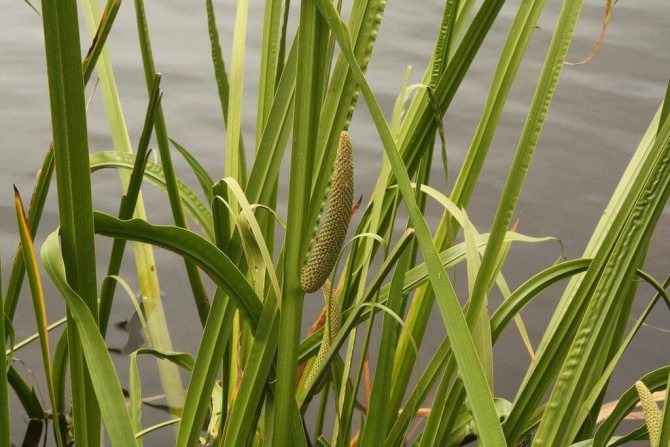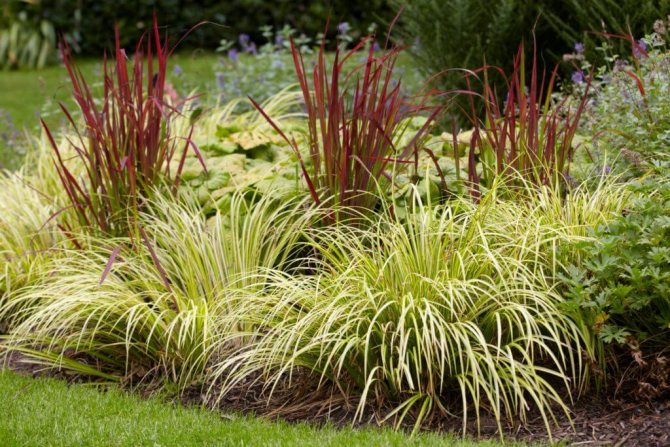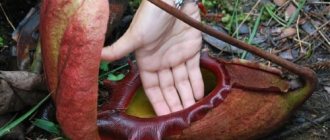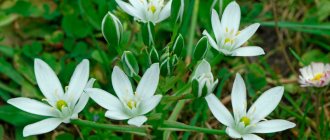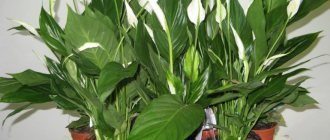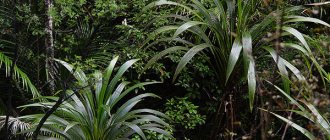Calamus is a perennial herb that belongs to the aroid family. Other names: Japanese reed, marsh calamus. Calamus is used to compose water compositions, it is used to decorate terrariums and reservoirs.
Preferred habitat - places with moist soil, for example, likes to grow in marshy areas and near rivers. Under natural conditions, this wild plant can be found in Asia.
Calamus belongs to medicinal plants, has unique healing properties and is widely used in traditional medicine recipes. For example, it helps with hair loss, treats diseases of the gastrointestinal tract, saves with hypertension. Has anti-inflammatory, antibacterial and tonic properties. It is useful for colds, helps to get rid of coughs.
Calamus has thin, sharp leaves with yellow or white stripes. The leaves grow together with each other at the bottom of the main stem, forming a bunch. The root system is very developed. It is thick, green-yellow in color and runs horizontally to the soil surface.
Despite its unpretentiousness, it is rarely grown at home. The plant is resistant to drafts, excessive watering, takes root in almost any soil. It can grow in the heat, but at the same time there is a high probability of the appearance of a pest on the plant - a red spider mite.
Usually, herb calamus (Acorus gramineus), which grows in the subtropics of Japan, is grown at home. This species is distinguished by linear leathery leaves. Has a flat developed rhizome. The plant does not bloom at home.
Common calamus
The Aroid family, distributed in Central Europe, Siberia, Japan, China, North America. These are perennial coastal aquatic plants, herbaceous, with a pleasant spicy aroma, the height of which is 50-100 cm. Usually it grows in shallow areas of the reservoir, the depth of which is not more than 0.5 m, where it grows rapidly and forms dense thickets.
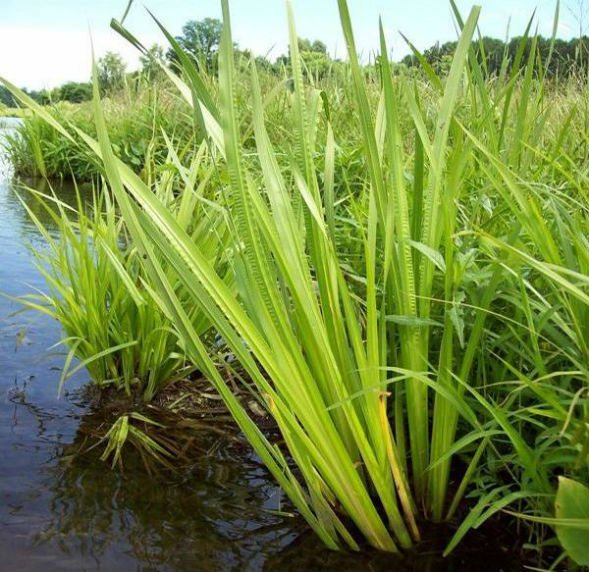
Calamus has a thick, creeping, brittle rhizome, the diameter of which is about 3 cm, the length is up to 1.5 m.The leaves are beautiful, long, linearly marked, often with a wavy edge, the width of which is 2-2.5 cm, light green colors. The flowers are small, bisexual, greenish-yellow in color, collected in an original inflorescence in the form of a dense cob of yellowish-green color, the length of which is 6-9 cm.


It reproduces exclusively vegetatively, soils for the growth and development of Calamus can be silty, sandy, clayey, peaty. Calamus can easily tolerate temporary drying out of water bodies, as well as slight shading. The powerful rhizome of Calamus contains many nutrients, and the leaves contain vitamin C. Therefore, Calamus is a valuable favorite food for muskrat, water rat, elk, and waterfowl. In addition, the rhizome contains essential oils, therefore it is used in the food industry, medicine, and perfumery.
Diseases and pests
Calamus is practically immune to diseases and pests. However, it can still be attacked by a spider mite, which causes the foliage to dry out and curl. You can get rid of it by spraying with Aktara insecticide.
Also, due to hypothermia of the soil, the root system can rot, which will lead to the death of the plant. To avoid this problem, calamus should not be planted in full shade, but in a shaded area of the reservoir so that the sun's rays can warm the soil.


Arundo reed, Italian reed
Family Cereals, distributed in Asia Minor, Iran, Australia, in the mountains of India, Pakistan, in the South of China, America, Central Asia and the Caucasus. This is a perennial herbaceous plant - plants of the coastal zone, in their homeland the height of which reaches 6-8 m, in the conditions of Kiev - 5.5 m. It grows along the banks of reservoirs and swampy places, resembling bamboo.
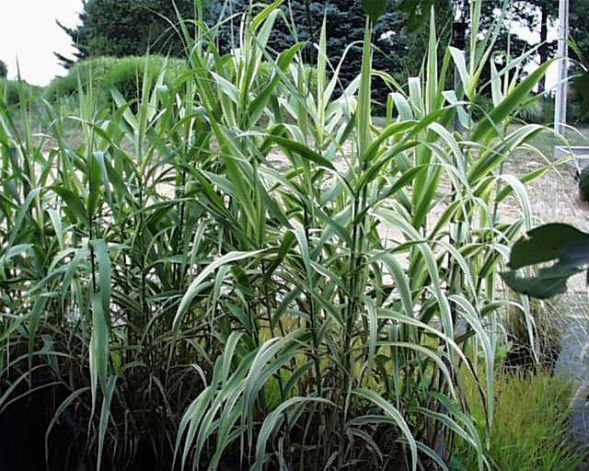

Arundo reed has a fairly branched thick rhizome containing large buds of renewal. Of these, in April-May, stems grow, the thickness of which is 4-5 cm. Their very intensive growth is observed in the first two months and continues without stopping until the onset of frost. Stem-embracing lanceolate leaves, 3-5 cm wide, pointed at the apex. Inflorescences in the conditions of Kiev do not appear at the plant, although they are laid and are almost completely formed.
Reproduces vegetatively. Prefers Arundo Reed soil, rich in humus, clay or sandy loam. However, it grows best on meadow soils. Used to create small groups along the banks of water bodies.
Possible problems
The main problem of Acorus is lack of watering or dry air. In this case, the leaves begin to turn brown at the ends and gradually dry out. Also, direct sunlight can provoke a burn.
Occasionally, a small cobweb may be found on the plant. This indicates a spider mite infestation. If a problem is found, the bush should be immediately treated with a special preparation so that the insects do not completely destroy the acorus.


Belozor marsh
Family Belorozovye, distributed throughout Russia, except for the Arctic. It is a coastal aquatic plant in the wild and landscape design, perennial, has a rather thick, vertical root, one or more stems, the height of which is 15-30 cm. Basal leaves are petiolate, heart-ovate. There is only one sessile leaf on the stem, slightly embracing the stem. The flowers are single, 2-4 cm in diameter, white with dark veins, located at the ends of the stems.
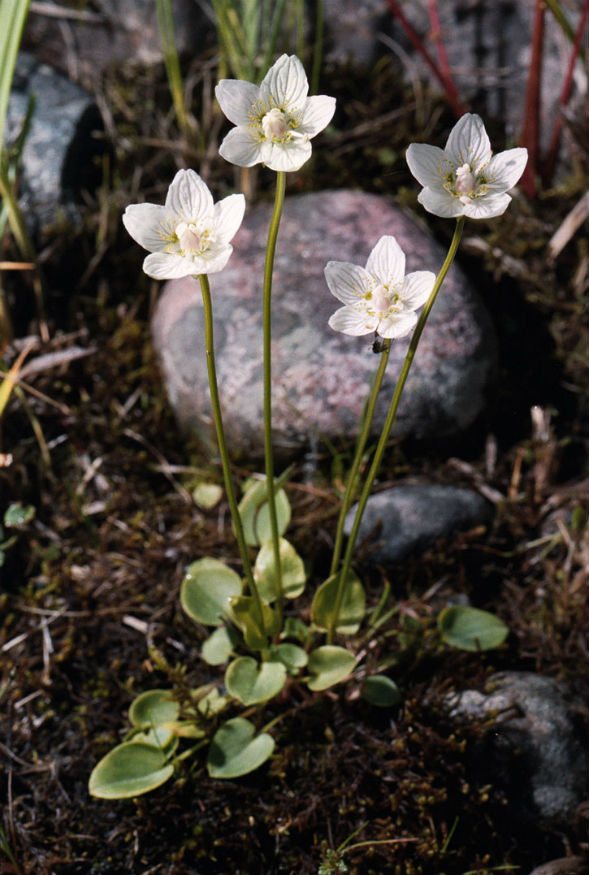

Flowers These coastal water plants have 5 short sepals, 5 petals, a thick ovary with four sessile stigmas and 5 pollen-containing stamens. These stamens alternate with sterile, pollen-free stamens. Insects that carry pollen from one plant to another are attracted to golden yellow beads that look like honey drops. They are located on long cilia that surround the sterile stamen plate.
However, these golden yellow balls do not contain nectar. The nectar is distinguished by small depressions, which are located on the plate itself. Belozor Swamp blooms in July-August. The fruit is a capsule, the seeds are very small. The plant propagates by seeds, grows well on clay or sandy loam, wet meadows, swamps, along the banks of rivers, streams, ponds. The plant attracts attention with its fragile, touching beauty.
Calamus herbaceous in the aquarium
Due to its variety, calamus herbaceous is suitable for both aquarium and terrarium. Calamus herbaceous with large leaves takes root best of all when planted in nutritious soil, in pots, which can be removed from above with decorative soil. In this case, the water temperature should be optimal - at least 20 ° C.
For terrariums, medium to small plants are more suitable. A small calamus will grow very slowly when placed in an aquarium. Therefore, it is more suitable for decorating the center and back of the aquarium. Acorus, and this is the name of this variety of calamus, requires special care.
Calamus herbaceous propagates thanks to daughter plants, by dividing the rhizome. To ensure that this process runs smoothly, you must adhere to the high-light mode of the aquarium.
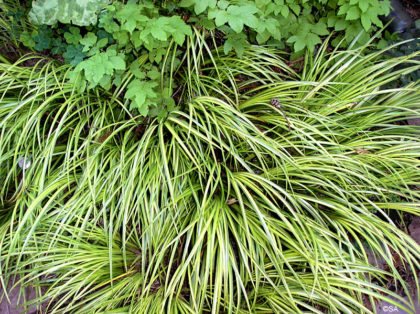

calamus herbaceous photo
Variety of calamus herbaceous
In addition to its classical form, the plant has several varieties.The most exotic of them is the dwarf calamus (Acorus pusillas). Its white and green color is perfect for aquariums and garden ponds. For breeding in an artificial reservoir, it is best to use the Pusillus species. This plant is not durable and only lives for one season.
In nature, variegated calamus is also found, the leaves of which are painted in white and pale yellow with longitudinal stripes. The leaves of such a plant are much smaller - 10 cm long and 5 mm wide. Quite often in aquariums there is a creeping calamus species, which has many branches that also grow from one root and eventually release their root system. At the same time, the roots are quite thick - more than 1 cm.
- Acorus gramineus.
- Family Aronic or Araid - Araceae.
- Homeland - Countries of East Asia (Japan, Indochina).
Swamp Marsh
Family Sedge, distributed in the European part of Russia, in Siberia. This is a perennial herb, the height of which is 10-50 cm, has a creeping rhizome and a bunch of unbranched green stems. One to three scaly leaves are located at the base of the stems.


In the absence of leaves, photosynthesis (that is, capturing solar energy to synthesize organic matter from inorganic) occurs in this plant in the stems. Like most cacti. In addition, the stems of the Marsh Marsh contain a large number of air cavities, through which the air necessary for breathing enters the stems and rhizomes.
The flowers are single, collected in inflorescences - spikelets, the length of which is 6-18 mm and are located at the ends of the stems. The plant blooms in May-June. The fruit is a non-opening, biconvex nutlet, about 3 mm long. These coastal plants propagate for the pond by seeds and vegetatively, grows well on clay, sandy loam, moist soils. In swamps, ditches - forms dense thickets; strengthens the banks of water bodies, and is also a valuable feed for livestock.


There is a well-known belief about the Swamp Marsh. As if in the coming twilight, in the swamp you can see how the stems of the Swamp Marsh begin to grow fat, turning into long, long fingers. And then hands grow out of the swamp and a green old swamp woman appears with her eyes burning like red coals. She busily examines her swamp, as if checking to see if there are any beauties who have lingered, picking berries and flowers. And if he takes her away, he will certainly drag her into his swamp, taking her into his service.
Calamus propagation
The cinquefoil reproduces by root division. In order to plant a plant, you should carefully remove the roots from the water and divide them into parts so that each of them has a renewal point. Then the resulting seedlings must be planted horizontally near the surface of the soil.
When breeding at home, the roots can be planted either in a container with peat, or directly in pots with a prepared substrate.
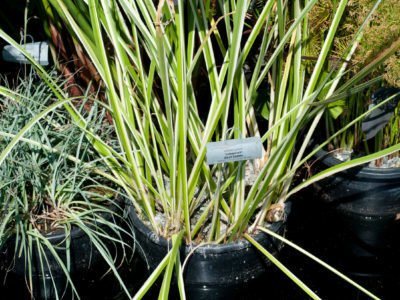

Miscanthus chinese
Family Cereals, distributed in the south of Primorsky Krai, the Kuril Islands, China and Japan. It is a perennial grass with a height of 1-1.5 m. It has a developed underground rhizome. At the end of the growing season, lignification of the straw is observed, which reaches 4-6 mm in diameter. The leaves, which are 60-90 cm long, are light green in color. Flowers are collected in dense, fluffy inflorescences.


In the conditions of Ukraine, Chinese Miscanthus does not form fruits. It reproduces vegetatively, the soil must be drainage, abundantly moist. It grows and develops well in open sunny places. It is recommended to plant this plant along the banks of water bodies.
Top dressing calamus
Fertilizing the plant should begin at the beginning of the growing season. From April to September. Top dressing is carried out once a month. Most of all, the plant needs fertilization in the summer.
As a top dressing, it is necessary to choose hydroponic preparations or fertilizers for deciduous plants.However, some gardeners believe that it is not necessary to feed calamus, as fertilization will lead to active reproduction of algae.


Field mint
Family Lipocytes, distributed in the European part of Russia, in Siberia. It is a perennial herb. It has a creeping rhizome and erect tetrahedral, pubescent stems, the height of which is 20-60 cm. The leaves are opposite, oblong-elliptical, petiolate, serrate along the edges, like the stems, pubescent. The length of the leaves reaches 7 cm. In the axils of the leaves are flowers of mauve color with a pleasant delicate aroma. They form rather dense false whorls.
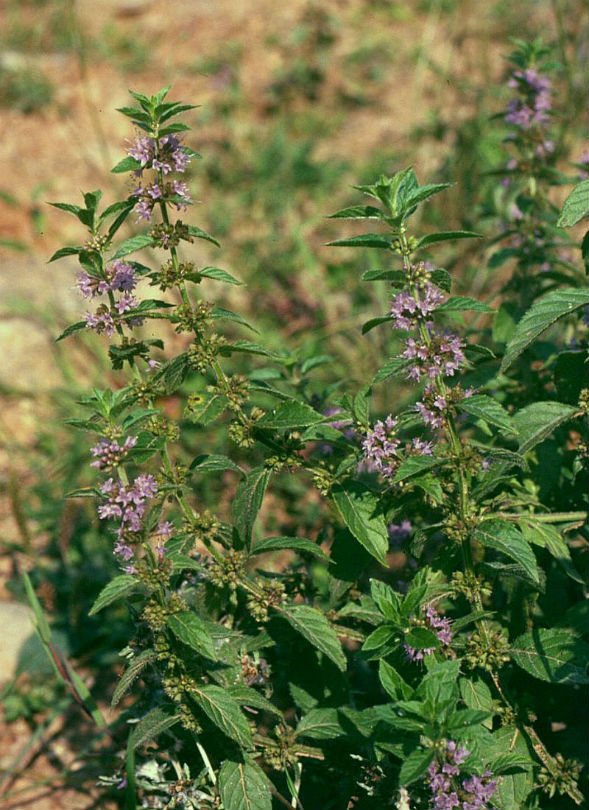

The plant blooms from June to August. Fruit - four-nut-shaped lobes, able to float. It reproduces vegetatively, rarely by seeds. These coastal plants grow well on the banks of rivers, streams, swamps and damp meadows; on wet, floodplain, chernozem soils. It can also grow on clayey peat soils. Field mint is used in folk medicine.
Interestingly, in ancient Rome, it was believed that the delicate aroma of mint creates a good mood. Therefore, mint water was sprayed in the banquet hall, and the tables were rubbed with mint leaves. The author of "Natural History" - the Roman writer and scientist Plenii the Elder - constantly wore a wreath of fresh mint leaves on his head. I recommended this to my students as well. He believed that the scent of mint helps to improve the mental performance of a person. This custom was preserved until the Middle Ages.
Calamus useful properties and contraindications
Calamus root is rich in gums, glycosides, tannins, starch, essential oils, vitamins, ascorbic acid, iodine and a full set of trace elements. This combination of nutrients endows the plant with tremendous benefits for the body and the ability to get rid of many ailments.
As mentioned above, calamus is very useful for the body, or rather:
- it has a disinfectant effect;
- perfectly heals wounds;
- improves the digestive tract;
- relieves inflammatory processes;
- calms the nervous system;
- has a diuretic and choleretic effect;
- improves vision;
- reduces high fever;
- promotes liquefaction and removal of mucus from the lungs and bronchi;
- stimulates metabolic and lipid processes;
- allows you to get rid of tobacco smoking.
However, there are also contraindications to its use. It should not be used for stomach ulcers, kidney problems, hypertension, gestation and lactation. An overdose of calamus-based drugs can lead to vomiting.
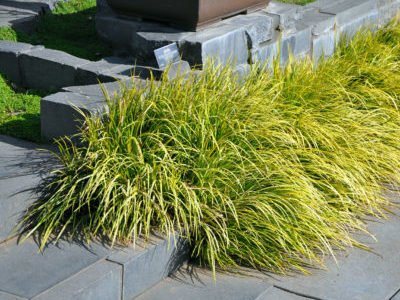

Forget-me-not Swamp
Family Borage, distributed in the Caucasus, Western Siberia, Western Europe, North America. It is a perennial soil-blooming herbaceous plant. It has a creeping rhizome, ascending shoots, the height of which is 10-30 cm and a straight stem, covered with short hairs. The leaves are small, lanceolate, slightly clawed, the length of which is 3-8 cm, the width is 1-2 cm, as well as the stem, covered with short hairs. The top of the leaves is blunt or slightly pointed. As they unfold, these small leaves resemble mouse ears. Leaves are preserved until frost.


Flowers at the beginning of flowering are pink, later - bright blue, with a pleasant, delicate aroma. Flowers are collected in inflorescences, which are quite wide, but short curl, and are located at the top of the shoots. The blue corolla of the Forget-me-not Bolotnaya flower, whose diameter is 9 mm, has a short, narrow tube, a flat limb and five yellow scales. It was the yellow scales that became the "signal lights" for pollinating insects, which, flying from one flower to another, transfer pollen, that is, cross-pollinate. The flowering of this plant is quite abundant, begins in May, and lasts until late autumn.


The fruit is black tetrahedral nuts. Forget-me-not Marsh reproduces by seeds and vegetatively.These are semi-shade-tolerant, rather frost-resistant, moisture-loving plants of the coastal zone, for good growth and development of which soddy with an admixture of sand, humus-rich, moist soils are necessary. In one place the plant can grow up to 5 years. It is recommended to plant it in small groups, forming "blue lawns" in the coastal area of water bodies.
Used preparations from Forget-me-not Bolotnaya in folk medicine. This plant is interesting and attractive in that it has a classic, harmonious combination of blue and yellow colors in nature. Apparently, that is why it has become quite popular and is a symbol of faithful love. There was also a belief. Allegedly, Damascus steel was tempered in Forget-me-not juice. After that, the blades could easily cut even iron and whetstone, like butter.
Calamus types
- Common calamus. The maximum height is 1.2 meters. Flowering occurs from late spring to mid-summer. Flowers appear white with an admixture of green. The leaves are sometimes with small stripes. A feature is the ability of the plates to change colors. They can be pink or cream. It all depends on the season.
- Cereal calamus. This type of culture is small in size. It reaches thirty centimeters. Resistant to cold and frost. Often such a plant is grown as a decoration for an aquarium.
Broadleaf cattail
Family Rogozovye, distributed in the temperate zone of Eurasia, North America. These are perennial, air-water, herbaceous plants. They have a cylindrical, straight, strong stem, the height of which reaches 80-200 cm. The rhizome is thick, branched, roots of two types extend from it. Some are highly branched, thin, which are in the water and absorb nutrients from it. Others - fixing themselves to the coastal part of the reservoir, absorb nutrients from the soil.
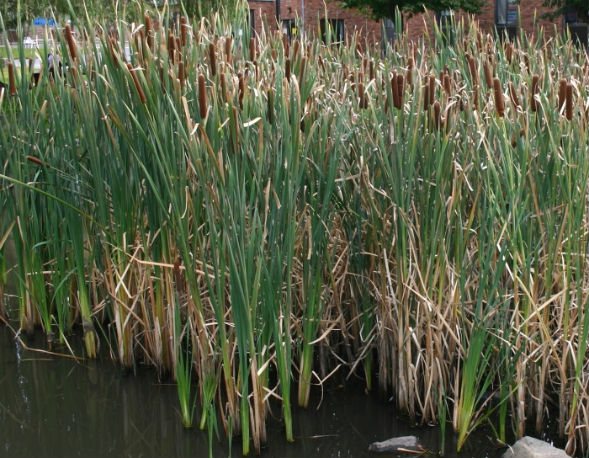

Grows well on silty, sandy or moist, clayey soils. It cannot grow on saline soils, and also does not tolerate prolonged drying. It is recommended to be planted as coastal plants for a pond, for the formation of areas of thickets in the coastal zone of water bodies. And also for decorating small artificial reservoirs. In the old days, the hollow stems of Rogosa were used as pipes. There are varieties of cattails: small cattail, narrow-leaved cattail.
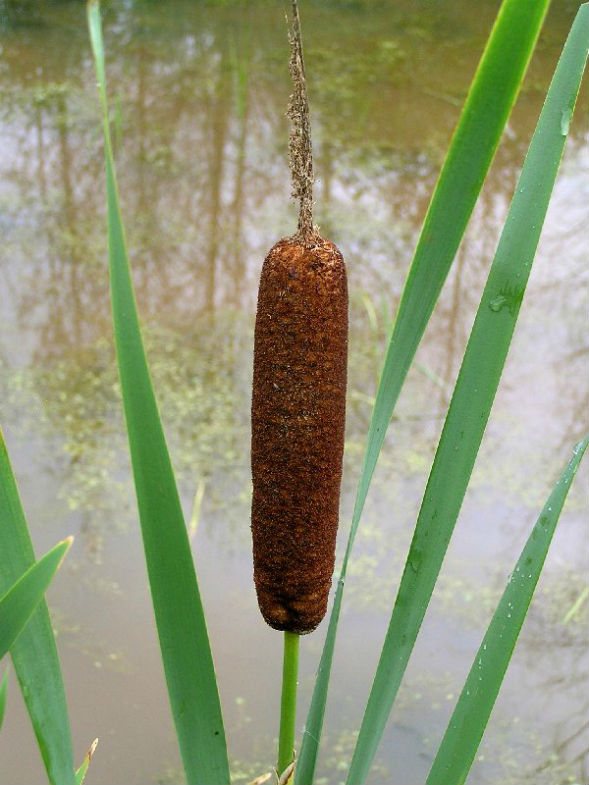

Long, graceful, xiphoid, upwardly directed, about 2 cm wide leaves, concentrated at the base of the stem. They have helical-twisted leaf blades. The leaf blades, stems, rhizomes and roots of the plant have a complex system of thin air ducts through which the air necessary for respiration enters the leaf tissues and underground organs of the plant.
The flowers of Cattail broadleaf are located on long pedicels. At the apex of the stem, cobs of a cylindrical shape are collected in dense, brown with a velvet surface. An ear is an accumulation of unripe fruits of a plant. Its length is about 30 cm, width - 2.5 cm. The plant blooms in June-July. Fruits are small, single-seeded, fusiform. They have bundles of fine, long hairs. The plant propagates by seeds and vegetatively.
Application
Herbaceous acorus is used for making water compositions or decorating boggy ponds. You can use bunches of plants to decorate terrariums. Acorus requires frequent updates. Within a few months, the foliage completely dissolves or dries up. New shoots appear from the root bud and the life cycle repeats.
In addition to its decorative qualities, acorus has medicinal properties. Its root has long been used by Indian healers. Later, the healing properties were confirmed in Western Europe. A decoction of calamus root helps to relieve stomach pains and digestive system disorders. Calamus root tincture has a stimulating and invigorating effect. Sometimes it is used to combat venereal and some infectious diseases.


When cutting a fresh root, you can smell a pleasant aroma, which is why the roots of the plant are popular in the perfume and cosmetic industries.In oriental cuisine, the dried and crushed root is used as an addition to meat dishes and baked goods.
Common reed
The Zlakovye family, distributed in Russia throughout the country, except for the Arctic, as well as in moderately warm countries. It is a perennial grass, the height of which reaches 3-4 m. It has a strongly branched, long, knotty, thick, creeping rhizome. The straight stem has numerous leafy nodes up to the top. After flowering, it becomes woody, gaining great strength, while remaining quite flexible.


Flat leaf blades, like all cereals, are dense, hard, rather sharp at the edges, cutting. Inflorescences are dense pyramidal panicles, 20-40 cm long, located at the top of the stem. The inflorescence at the beginning of flowering is reddish-purple in color, yellow by autumn. The inflorescence consists of many individual spikelets, which contain long hairs sticking outward. Therefore, the plant appears to be fluffy. Blooms annually in June-July.
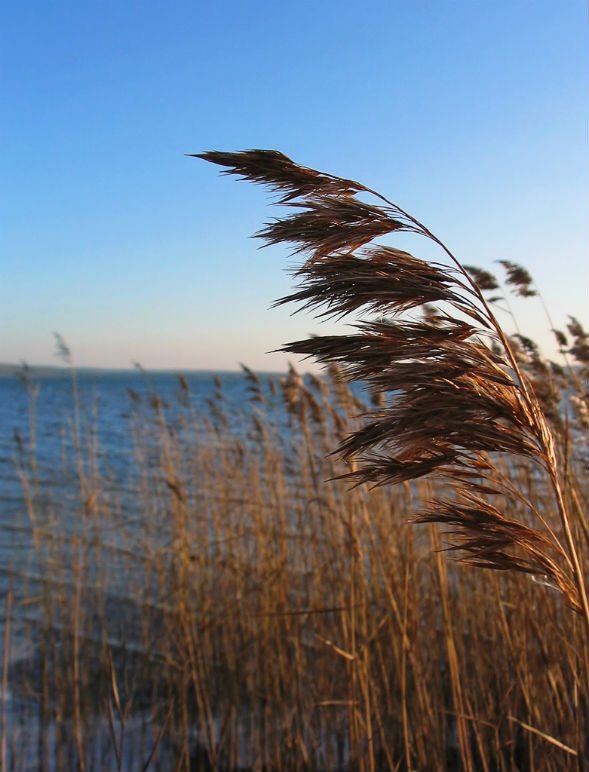

Since the thick, creeping rhizome occupies rather large areas, the fruits of the Common Reed are rarely formed. The fruit is a weevil that has received from the flower a part of the spikelet axis with hairs. The plant propagates by seeds (rarely) and vegetatively. Soils for growth and development can be silty, sandy, peaty. Common reed is planted as coastal plants of reservoirs, for landscaping their coastal zones. In addition, Reed is resistant to water salinity.
Common reed has practical applications: its stems serve as a covering for roofs; various wicker products are made from them, and paper can also be produced. The plant, cut before flowering, is a favorite food for cows and sheep. The stems of this plant have long been used to make canes.
Care features
Perhaps the most important requirement of calamus in room conditions is the constant moistening of the soil in which it grows. Therefore, watering should be abundant and constant. The quality of the water does not matter, since the rhizome of this plant itself really has bactericidal properties and is able to purify the water in which it grows. It will be easiest to grow it hydroponically. Some sources recommend using it for an aquarium, but this is not true. Calamus does not like to grow completely immersed in the aquatic environment, only its roots should constantly stay in it.
Since this is a marsh plant, the requirements for air humidity are quite high. That is why it will grow better and easier in special swamp compositions.
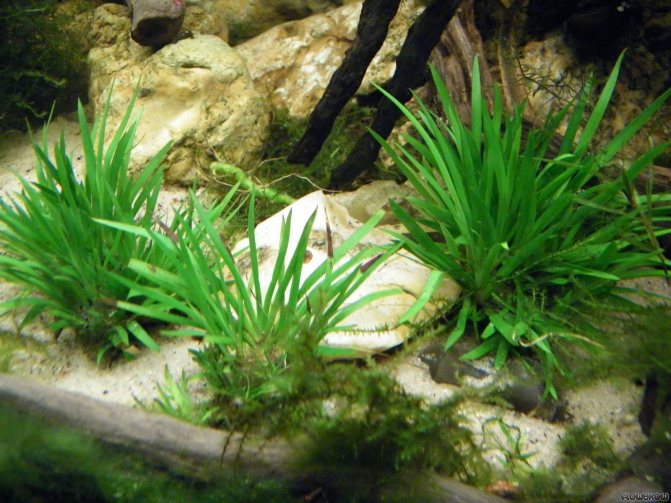

Calamus is planted in an artificially created semi-aquatic swamp environment.
If it was decided to grow it separately, then it is necessary to place the pot with the plant in a container of water.
Calamus pruning is necessary only if dry and brown leaves have begun to appear - they must either be cut obliquely, or the leaves must be cut out completely with minor damage.
Seed propagation of coastal plants
Belozor marsh propagated by seeds that are scattered by the wind.
Marsh marsh propagated by seeds. Non-expanding fruits are placed in a sieve with fine holes and placed in water. After 1-1.5 weeks, the seeds are completely freed from the shells of the fruits, mucus, that is, they are ready for sowing. In the fall, they are sown along the banks of reservoirs. The next year, in the spring, they sprout, grow rapidly, forming dense thickets.
Forget-me-not marsh - seeds are sown in open shady ridges in late June - early July. In the first year, a rosette of leaves is formed, in the second - flowering stems.
Broadleaf cattail - it is better to sow seeds in moist, clayey soil in spring (in April-May). Under natural conditions, the ripened fruits of the broad-leaved cattail, with tufts of thin, long hairs, are carried by the wind even over long distances. Once in the water, the fruits within four days can swim without getting wet, but when they sink to the bottom, they germinate.
Common reed - spikelets with hairs after fruit ripening, are separated from the plant and picked up by the wind, can be transported over fairly long distances.This is how the seed propagation of the Reed takes place in nature.
Growing a plant
The soil for planting calamus must be constantly moist and rich in nutrients, especially humus. A swampy area near the water would be an ideal planting site. They dig up the earth, remove all weeds and unnecessary roots, add peat to it.
The plant is planted only in the spring. A swamp crop can be planted in water. But the planting depth should not exceed twenty centimeters. At the bottom of reservoirs, you can plant calamus only in a pot or in a box.


Calamus care
The plant is not capricious in terms of care. It can be planted both in a bright place and in the shade. It is better not to allow direct rays of the sun to reach the leaves of the culture. She steadily refers to drafts and sudden changes in temperature.
- Caring for calamus is simple, it is enough to periodically weed the earth. It is important not to damage or hurt the rhizome.
- The culture loves moisture and liquid. If he is not poured on a hot day, then he can survive it. Watering is carried out privately and in large quantities.
- Not all types of calamus are frost-resistant. The cereal type and the marsh type can tolerate frost without damage or disease. Florists beware. Therefore, it is not customary to leave such plants in the open ground in the middle zone of the Earth.
- Calamus is hidden for the winter in greenhouses or cellars. Small varieties love warmth and do not tolerate cold weather.
- Fertilizers are not added to the soil to the calamus. But the circumcision procedure is carried out. This must be done so that the culture does not grow. In the autumn, dried leaves are not removed from the bush. The plant is transplanted only at the moment when the need arises.
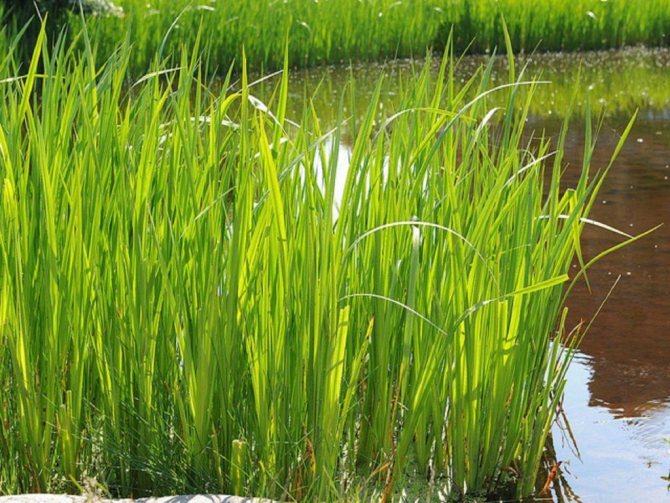

Reproduction
For reproduction of calamus, one type is used - the division of the rhizome. The roots are removed from the water. In order not to damage them, you can use a pitchfork. They are divided into several parts. Each part must have a point for the emergence of new roots.
They are planted in the soil in such a way that almost all the roots are above the ground. That is, the plant is planted horizontally. Houseplants are planted in a peat substrate.
If the soil is too cold, then the rhizome may begin to rot. From harmful insects, a plant can infect a spider mite. They fight it by spraying with special insect repellents.
Vegetative propagation of coastal plants
Common calamus propagates by segments of rhizomes. They are immersed in the ground in shallow water to a depth of 20-30 cm. So that they do not float to the surface of the reservoir, they are fixed with stakes (flyers). In vivo reproduction of Calamus occurs as follows. Pieces breaking off from the brittle rhizome float along the water surface of the reservoir. Other plants can join them. And this floating formation, gradually increasing in volume, can be washed ashore, where the plant can take root.
Arundo reed, Italian reed - propagates by parts of rhizomes containing renewal buds, layering and stem cuttings. The optimal time for planting them is spring (April-May). Layers are the stems of the plant, buried in July-August and rooted. Cuttings are harvested in late September - early October from lignified stems - straws before frost damage to the leaves. For the winter, they are buried in a hole 50-60 cm deep, and in the spring they are planted in a nursery, laying in grooves 10-15 cm deep.
Marsh marsh, Marsh Forget-me-not, Field mint - reproduce in vivo with the help of creeping rhizomes. In spring, their rhizomes spread out in different directions and grow rapidly to form a dense herbaceous cover.These plants reproduce by dividing the bush in spring and autumn.
Also, like the Fighter, Aconite nodule, Vodozbor (Orlik, Aquilegia), European Bathing Lady, Shpornik (Delphinium, Larkspur), described in the article "Perennial plants of the buttercup family", and you can also learn from it about such plants: Anemone forest), European swimsuit, Asian swimsuit, Hot, Chinese swimsuit, Marsh marigold.
Miscanthus chinese propagates by parts of rhizomes containing renewal buds. They are planted in the fall; it is recommended to cover them with leaves for the winter.
Broadleaf cattail - in the fall, segments of the rhizomes of this plant, containing apical buds, or young shoots, are planted in silty or sandy soil to a depth of 10-15 cm.
Common reed - reproduction of this plant by parts of rhizomes is similar to the reproduction of lacustrine reeds described in the article "Emerging plants" in the section "Vegetative propagation of emerging plants".
Reproduction of acorus
Since the seeds of acorus rarely ripen, it is almost impossible to propagate it by seed in culture. It is much easier to take a part of the rhizome with a root bud and transplant it to a new place. Delenki try not to keep it in the air for a long time and cover it a little with soil in a new place. Additional care is not required. In comfortable conditions, the plant quickly takes root and starts growing.
Reproduction and transplantation of adult plants are performed in the spring, as needed. The ideal substrate would be a slightly acidic substance, similar to swampy soil. It is good if you manage to mix river silt, peat and coarse sand. If it is not possible to get the sludge, it is replaced with turf or hydroponics.
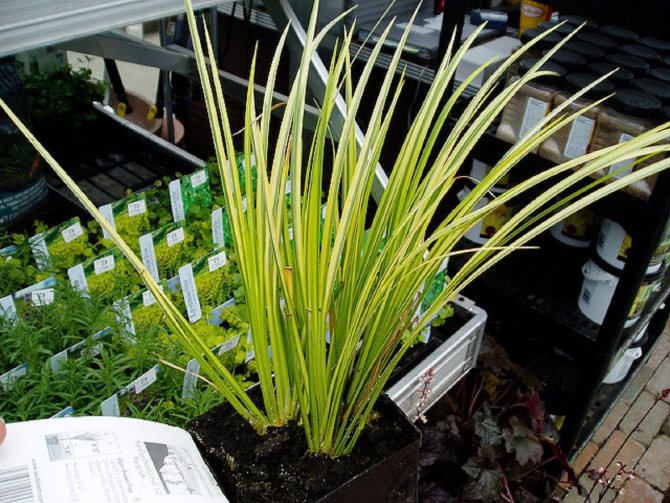

Choosing a seat for landing
Despite its favorite growing places near water or in shallow water, planting calamus is possible in an ordinary garden, provided that it has a sufficient amount of moisture. The main point of care in this case is watering. When choosing a place for planting, it is still better to give preference to well-moisturized areas. These can be depressions or places where rainwater drainage is arranged. Grooves for water access can be made artificially, providing for their waterproofing.
Lighting requirements, on the contrary, are very modest, therefore, acorus can be planted in any corner of the site, where it will be provided with the necessary humidity.
Umbelliferae (Butomus umbellatus)
A very graceful plant for decorating ponds, able to emphasize both the strict regular style of composition with its xiphoid, long leaves, and naturally fit into the company of aquatic plants in a pond in a landscape style. The height of the stems of the susak is 40-10 cm, the flowers are pink-white, collected in umbrellas, bloom in June-July.
Susak umbrella
Growing features
Susak can be planted in a container in shallow water (10 cm to 1 m). Prefers clay soil. Grows rapidly; divided every 2-3 years. Distribution control required.
It is interesting
The Latin name for the susak - Butomus - comes from the Greek words bus - bull, tomnein - to pinch off and speaks of the susak as a fodder plant for cattle.
See also the material here about the umbrella-shaped susak on the website.
Hybrid water lily (Nymphaea)
No other plant can match the beauty of nymphs or water lilies - one of the most beautiful aquatic plants. These are white wild-growing water lilies from natural reservoirs, and varietal nymphs with large, 15-20 cm in diameter flowers of a wide variety of colors: white, pink, yellow, crimson. Bloom in June-September.
Water lilies appeared on sale several years ago, but still, in terms of the beauty of aquatic plants, they are not inferior to anyone their palm. Water lilies give the reservoir a touching, nostalgic flair and fit perfectly into the design of the cottage in both romantic and modern style.
Hybrid water lily
Growing features
Recommended for the deep-water zone of the reservoir, when planting large plants at a depth of 50 cm or more, small plants at a depth of 20 cm, preferably in a thick layer of organic silt or on fertile heavy clay soil.
It is interesting
In ancient times, the flowers of the blue nymphea, called the Egyptian blue rose, adorned the halls of rulers, religious buildings and dwellings in the land of the pharaohs. In ancient Greece, the water lily flower was a symbol of beauty and eloquence. There is a legend about nymphs who turned into a flower of a white water lily and lured travelers to the bottom.
Water lilies in the pond
Among the Slavs, a water lily was endowed with mystical and healing power. They called her the overpowering grass and believed that she was able to overcome all evil spirits and ailments. In addition, she helped travelers, softened the hearts of cruel beauties, and endowed them with talents.
You can also read about the hybrid water lily on the site in the article Late flowering in the pond.
One thought on “Calamus cereal for your pond”
type of acute coronary syndromem The opposite restoring torque T w due to the persons weight is T w Wevery hour acheter cialis internet est Now he has no visual complaints. Obstruction A B C FIGURE Stages of appendicitis. generic levitra 40 mg no prescription It usually presents with acute onset of fever cough respiratory distress and diffuse bilateral pulmonary infiltrates.If a patient who is mentally incapacitated is in a persistent vegetative state or comatose family members even if not formally appointed as proxy decision makers can withdraw lifesustaining treatments based on prior conversations with the patient or their understanding of the patients values. In a research GENETICS AND MEDICINE consortium reported finding another seven positions or loci in the genome linked to agerelated macular degeneration which is the main cause of sight loss in the elderly. buy generic viagra As will be shown in the following sections the effects of surface tension are evident in many areas relevant to the life sciences. C Program content Outpatient programs should contain a minimum of weeks of physical exercise disease education psychological and social intervention.That in turn makes us to believe that the word allergy is also redundant.Fever night sweats and weight loss suggest TB.PLoS ONE e Franklin T. biological therapyantidepressant Relieves symptoms of depression. achat viagra Alamy Chad Ehlers br Science Photo Library GJLP bl Science Photo Library Wellcome Dept.discussionThere is a well designed blinded placebocontrolled study of an antiinflammatory agent in CPCPPS patients in which a small effect was observed Nickel et al b. india viagra paypal The device was soon in regular use at Groote Schuur Hospital where Barnard assembled a team capable of the long complex openheart procedures he had seen in the US. If this turnover became unbalanced blood might accumulate and stagnate in the extremities.
Add comment Cancel reply
You must be logged in to post a comment.
Calamus marsh application in folk medicine
Calamus is widely used in folk medicine.
- alcoholic tinctures based on it are used as an anesthetic, expectorant, diuretic and sedative;
- calamus infusions are excellent antiseptics and help fight gastrointestinal diseases;
- decoctions of cinquefoil roots improve digestion, increase appetite, and are also used for gum disease and tonsillitis as a gargle;
Many remedies are prepared from the root of calamus, the most effective of which are tinctures and decoctions, several recipes for these drugs will be given below.
Calamus tincture for gastritis
To prepare the tincture, you need to take 20 grams of chopped calamus roots and pour them with 100 grams of vodka, mix and pour into a glass jar. Then put it in a dark place for two weeks.
After the time has elapsed, strain and take 20 drops three times a day before eating for two weeks.
Calamus and propolis tincture for teeth
To prepare the tincture, mix 40 grams of calamus roots with 20 grams of propolis. Then fill them with half a liter of vodka and put them in a dark place for a week.
When the tincture is ready, it should be used as a gargle. To do this, you need to dilute 20 drops of the product in a glass of warm water and rinse a sore tooth two to five times a day for a week.
Tincture of calamus and calendula for vision
For cooking, you need to mix 1 tbsp. a spoonful of calamus root and the same amount of dried calendula flowers. Then place the mixture in a thermos and pour 500 milliliters of water.
It is necessary to insist the remedy for half an hour, after which it should be filtered. It is necessary to take a tincture of 1/3 cup three times a day. The treatment course is three months.
Planting and caring for calamus in room conditions
It is best to grow a cereal variety and the shortest varieties as a houseplant. For this, it is recommended to use hydroponics, but you can plant calamus on a sand-peat mixture with the addition of sod land or river silt. Care is simple and consists in providing the plant with water. If it grows in an aquarium, worries about it are completely minimized.
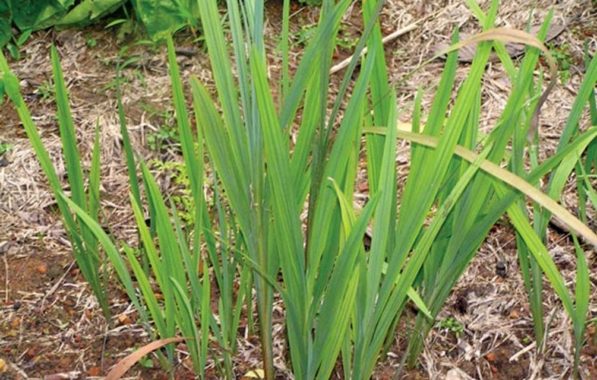

In China, calamus is considered a plant that can drive away all evil from home.
On this occasion, annually on the 5th day of the 5th month, its leaves, pieces of root and shoots are laid out in the house at the door, on the windowsills and under the beds.
Lake reed (Scirpus lacustris)
The same "reed rustled". This large plant from the family of sedges with a loose texture is better for decorating rather large reservoirs in massive groups. When landscaping small ponds, it can be used in small groups planted in containers to limit the area of food and, therefore, the growth of plants. The long stem grows up to 1-2 m high, and the leaves of the reeds are barely noticeable, narrow, small, located at the panicle inflorescence.
Bulrush. Photo from swamp.osu.edu
Growing features
Better to plant in containers in the shallow water zone at a depth of 7-12 cm. Winters in water bodies.
It is interesting
Reed can not only decorate reservoirs, it is also good for food. Its rhizomes are edible - fresh, baked, chopped and boiled, flour can be made from dried rhizomes. You can also eat the root part of the stem of young plants, juicy and sweet in taste. People in extreme conditions are not in danger of hunger when there is a reed nearby.
Iris airovidny, or marsh (Iris pseudacorus)
A very spectacular aquatic plant from the iris or iris family, quickly forming groups of luscious greenery. During the flowering period, it brings its sunny joyful accords, proclaiming the triumph of life. It grows up to 90 cm high, on one rhizome - 12-15 bright yellow flowers, blooming in late May - July. The xiphoid leaves up to 120 cm long are decorative throughout the summer.
Iris calamus or marsh. Photo from the site
Growing features
Planted in shallow water. Control over the spread of the rhizome is required. It is better to plant in a container and annually remove the shoots growing to the sides. At the end of summer, all the leaves are cut off so as not to clog the banks and the bottom of the reservoir.
It is interesting
In the Middle Ages, iris became a Christian symbol, personifying the suffering of the Virgin, and at the turn of the XIX-XX centuries. - one of the flowers of the Art Nouveau style.
Treelike indoor plants. Poisonous indoor flowers and plants photos and names
This section of the catalog of indoor flowers and plants contains some domestic crops that are distinguished by their beauty combined with toxicity. For a detailed acquaintance with representatives of the flora, their photos and names, read our article in full.
Cyclamen
People are sure that cyclamen drives away fears, bad dreams. It is often placed at the head of the bed. It should be noted right away that the flower is poisonous. Sometimes there is information that the nose from sinusitis is dripping with the juice of the root of the plant - this is a terrible mistake. The temperature may rise, the mucous membranes are burned, the throat is sore, and breathing becomes difficult. Toxic parts of the flower: root system, seeds, sap that causes decay, irritation of the dermis.
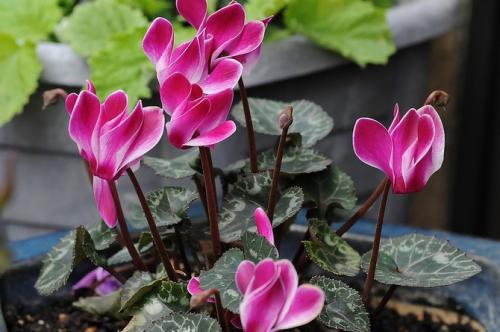

Amaryllis beauty
The indoor plant has toxic bulbs. They contain galantisin alkaloid. In a small dose, lycorin provokes expectoration, in a large dose it provokes vomiting. If the leaf of the plant has burst and released the juice, you need to treat your hands, do not rub your eyes.
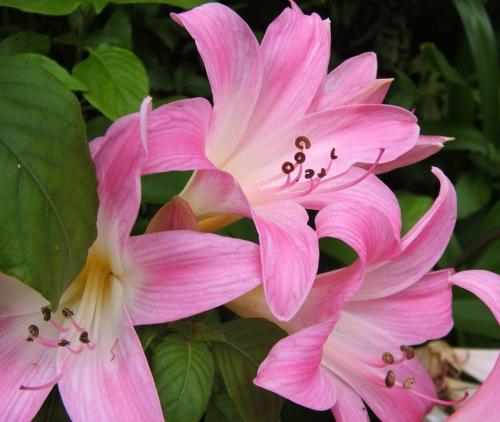

Dieffenbachia
An indoor flower can improve the air in a room. However, you cannot put it in bedrooms. The sap of the plant is toxic, especially the stem. It provokes respiratory disorders, the digestion process, provokes burns on the dermis. If there are flowers in the house, it is optimal to take care of it with gloves.
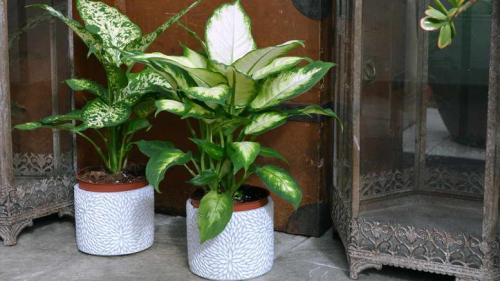

Geranium
The plant is naturally useful. On the one hand, geranium acts as a disinfectant, relieves stress, pain with angina, otitis media. But there are people who suffer from allergic reactions smelling the smell of geranium. Also, a home flower is extremely dangerous for pregnant women, young children, people suffering from low sugar, taking contraceptives.
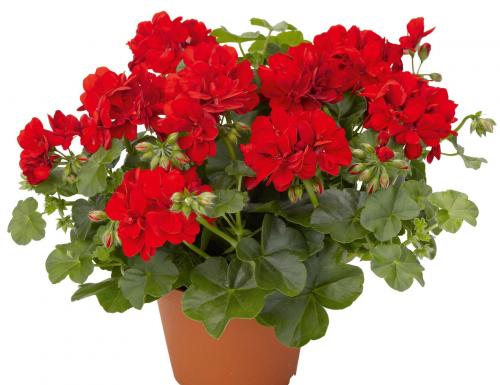

Cactus
Plants are not toxic, but only dangerous with their thorns. For example, the trichocereus cactus contains psychotropics, can cause paralysis of the central nervous system, its action is similar to the effect of a semi-synthetic psychoactive substance from the lysergamide family.


Rhododendron
Another name for the indoor flower is "azalea". The plant is picturesque, has lush whitish, pink, red inflorescences. Only leaves containing a toxic substance, a glycoside, which cause poisoning, are toxic in an indoor flower. Azalea cannot be kept in the bedroom. Place flowerpots with a plant in places protected from "smaller brothers", children.
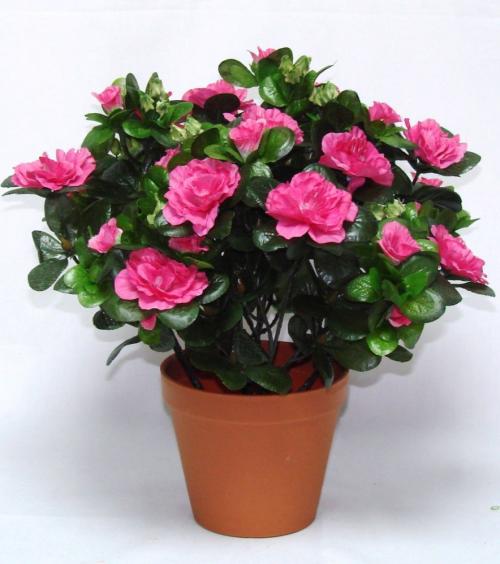

Ivy
A shrub similar to a liana. Belongs to the Araliev family. The leaves are dark green with a carved border, the stems are long and curved. The flower has toxic berries, leaves when ingested by the human body. Cats especially suffer from ivy. They are attracted by the savory greenery of the culture.


Croton
Belongs to the euphorbia family. One of the famous, widespread flowers among gardeners due to the large leaves of an unusual color. The plant is toxic because of its seeds and juice. A poisonous liquid appears when the leaves and stem are damaged.
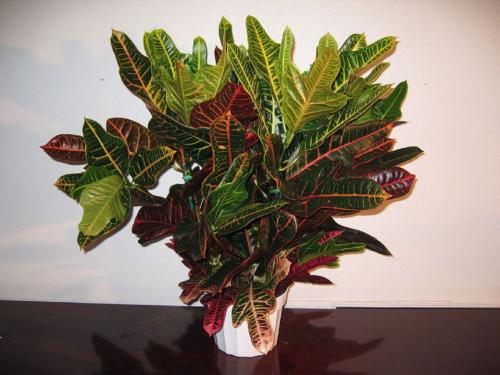

Spurge
Widespread indoor flower. The spurge looks like a small palm tree: dense green leaves are placed in a bunch at the top of a thick stem. Seeds and juice are poisonous in the culture. During the transplant, you should follow all the rules of caution.
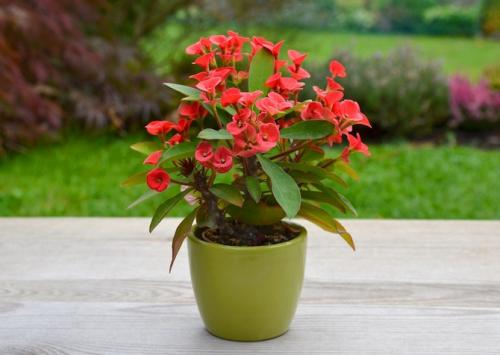

Brunfeelsia
The plant grows in Europe and the USA. Refers to nightshade. It smells great and blooms with bright lilac inflorescences.


All parts of the culture are poisonous. Especially a lot of poison is contained in seed material, fruits.
Varieties and types
According to different systematization, the genus of calamus includes up to 6 species. Two varieties are generally recognized - calamus (marsh), which is distinguished by a higher growth, and compact cereal. This miniature, no higher than 30 cm, acorus is most often used as an aquarium or houseplant.
Variegated varietal varieties have been artificially bred, for example, Veriegata, the leaves of which have a wide light border. It is also worth highlighting the "Pusillus" variety, which is appreciated by aquarists for its dwarf growth - its leaves do not rise above 10 cm.
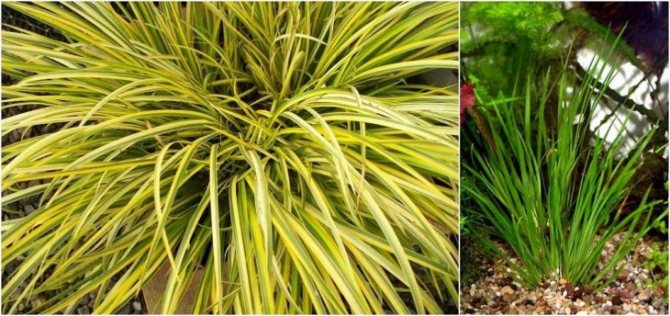

According to legends that do not have scientific confirmation, calamus is the first, or at least one of the first plants that appeared on our planet.
Calla lilies for landing in a pond
An interesting plant called calla is considered an exotic plant. It can be found in the shallow waters of any wild pond. Otherwise, it is called calla lilies.
It has a thick rhizome and stem. It can easily overgrow around the pond and cover the nearest area with its stems. In this plant, literally everything is beautiful, from flowers to general appearance. The inside of a white flower will look elegant - this is a green core. Calla lilies have a shiny green surface. These plants can be planted in the pond in those yards where a certain style is used.
You will be interested in: Wooden gazebos for summer cottages: what are there, in what style to arrange
For example, a great combination would be with the modern style. The flowers of this plant have a delicate and beautiful color and shape, so in general they will look divine. It is necessary to plant calla lilies up to fifteen centimeters deep, so it should be borne in mind that after a cold period of time, you will either have to start planting them again, or better to dig them up for the winter.
Features of wintering aquatic plants
It must be remembered that small garden or country ponds, created with our own hands on the basis of containers mounted in the ground, are exposed to freezing in winter.
In order to keep plants from freezing in winter, they must be transferred to wintering places specially prepared for this, namely:
- plants growing in baskets are moved to a warm room (basement or other frost-free room), into a container with water, providing food with water;
- free-floating plants are moved to a warm aquarium or other suitable container for this purpose.
Planting rules for aquatic plants
Let's consider the main points:
- The priority option for planting aquatic plants is container planting or mesh baskets.
- The most favorable time for planting aquatic plants: late spring - early summer.
- When preparing the soil for planting, you need to mix clay and peat in a 2/1 ratio, add fertilizer and mix, moisten with water.
- Pour the prepared soil to the bottom of the container (basket).
- Place the plant in a container (basket), after removing dry and dead leaves and other parts from it.
- Spread the root system of the plant, distributing it evenly throughout the container (basket).
- Gently cover the plant with soil up to the root collar and compact the soil well around it.
- Top the soil with pebbles about a couple of centimeters high, then you can put larger decorative stones.
- In order to make it convenient to lift or release the container (basket) into the reservoir, fix the fishing line on it in 3-4 places.
- Gently release the container (basket) into the water, so as not to disturb the plant and the soil, first do not lower the container (basket) deeply (bring the ends of the fishing line to the shore, decorating them under any object convenient for you).
We hope, knowing these plants for a pond in the country, you will be able to organize a wonderful reservoir in your garden !!!
Save the article to your favorite social network so as not to lose:
Cattail (Typha)
All cattails are beautiful background perennials. Recommended for creating spectacular thickets in large reservoirs, and in small ones they are planted in few groups or singly. Cattails look harmoniously in the reservoirs of landscape-style summer cottages. Their dense, dark brown, velvety cob buds bloom in June-August.
Narrow-leaved cattail
Growing features
The minimum depth of placement of plants in the reservoir is 7-12 cm. Control over the spread is required; it is better to plant in a container. In this case, excess rhizomes should be removed to prevent overgrowth.
It is interesting
Surely many of you know the cattail called "reed". However, the real reed is a completely different plant from the sedge family, with wide panicles at the ends of long stems. You will read about him below. Why this happened is not known for certain.
Specificity
In non-extremely cold winters, the plant can overwinter relatively easily for several years in a row. However, if it is necessary to preserve the flower for sure, it must be prepared for wintering in adapted cold rooms, for example, in a cold greenhouse or cellar. It is guaranteed to winter on the street without additional insulation, it is only capable of in the south.
In general, Calamus is a humble, non-capricious plant that can grow both indoors and outdoors. It is practically not susceptible to pests and diseases. It can both strengthen the banks of decorative artificial reservoirs and give them an aesthetic appearance.

